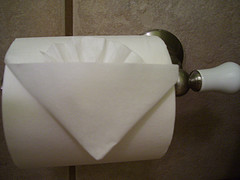AARP Eye Center
Hemorrhoid Help: 7 Things You Should Know
By Candy Sagon, February 18, 2013 09:00 AM

No one likes talking about hemorrhoids, but they're obviously a problem for a lot of us: In 2012, more people searched Google for information on hemorrhoids than any other health condition.
That's not really surprising, considering that the National Institutes of Health says half of all Americans over the age of 50 have hemorrhoids. And 75 percent of people will suffer from them at some point in their lives. (Women often get them during pregnancy and after childbirth.)
So what exactly are hemorrhoids? They're basically varicose veins of the tush. The veins in the anal area and lower rectum become swollen and inflamed - often from constipation, straining during bowel movements and too much sitting, among other things. Unfortunately, hemorrhoids are more likely as we age because tissues stretch and don't provide as much support to the veins.
There are two kinds of hemorrhoids, explains Herbert Lerner, M.D., medical officer with the Food and Drug Administration (FDA), which evaluates products and devices used to treat and remove hemorrhoids. There are internal ones that you can't see or feel, but can cause bleeding, and external ones that are at the anal opening and cause a lot of itching, pain and discomfort.
Over-the-counter creams can provide temporary relief, but they're not a cure, Lerner says. They also shouldn't be used for more than a week without a doctor's approval because they can cause the skin to thin and other side effects.
Hemorrhoid symptoms can also include bright, red blood smears on toilet tissue, stool or in the toilet bowl. If the blood is thick and dark, however, it could indicate a more serious problem, such as colorectal or anal cancer, and you should check with your doctor.
Here are seven things you need to know about preventing or treating hemorrhoids:
- Stop reading in the loo. Sitting for a long period of time, especially sitting on the toilet, can cause or worsen hemorrhoids, the experts agree. So if you're sitting on the can and reading - and a 2011 study by Staples, the business supply company, found that 35 percent of people took their iPad into the bathroom - you need to stop. Read elsewhere. It's not only healthier for you, it's more hygienic.
- Wipe wet. The best way to keep from irritating already inflamed tissues is to wipe them with either wet toilet paper or, better yet, wipes moistened with witch hazel (like Tucks). Chill the witch hazel or the wipes for even more relief. Avoid wipes that contain alcohol (ouch!) or fragrance, both of which can irritate. If you're in severe discomfort, an ice pack or cold compress held to the area for a few minutes can help reduce swelling.
- Bathe and blow-dry. Sit once or twice a day in a warm bath for 10 to 15 minutes. You can also use a sitz bath (from the German word "sitzen," meaning "to sit"), with just enough warm water to cover the buttocks. This helps keep the area clean and can relieve pain and itching. Afterward, use a blow-dryer set on low to air-dry the area, according to the Mayo Clinic, to avoid rubbing sensitive tissues.
- When you need to go, go! When you feel the need for a bowel movement, go to the bathroom immediately, advises an article from Harvard Medical School. Waiting can cause stool to back up, leading to increased pressure on the weakened veins. Harvard doctors suggest setting a time each day, such as after a meal, to sit on the toilet for a few minutes to help establish a regular bowel habit.
- Increase fiber. The best way to prevent hemorrhoids, says FDA gastroenterologist Rajat Malik, M.D., is to keep stools soft so they pass easily. You want to avoid constipation, which can cause straining and tearing from hard stools. Do that by drinking plenty of fluids - including a glass of water when you first get up, some suggest - and slowly increasing the fiber in your diet, by adding fruits, vegetables, beans and whole grains.
- Move more, sit less. Stay active to help prevent constipation and to reduce pressure on veins, which can occur with long periods of standing or sitting, says the Mayo Clinic. Regular exercise can also help you lose excess weight that may be contributing to your hemorrhoids.
- Consider surgical treatment. When home treatments aren't enough and symptoms have worsened, it's time to consult a doctor. Some of the less invasive procedures available include rubber band ligation, which cuts the hemorrhoid's blood supply with a tiny rubber band; and coagulation, which uses a laser or infrared light to shrink hemorrhoids. If a blood clot has formed in an external hemorrhoid, a doctor can remove it with a simple incision, which can provide relief, the FDA's Lerner says. A relatively new procedure is Doppler-guided hemorrhoidal artery ligation, which uses Doppler radar to find hemorrhoidal veins so blood supply can be cut off. Large, more severe, hemorrhoids may require more extensive surgical procedures: a hemorrhoidectomy, to remove more of the tissue, or hemorrhoid stapling. Talk to your doctor about the side effects, recovery time and chance of recurrence with each type of procedure.
Photo: woofiegrrl /flickr























































